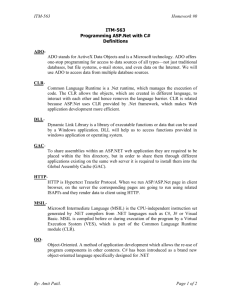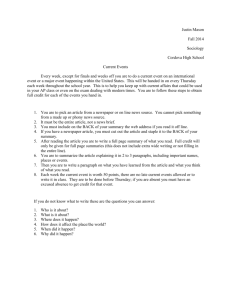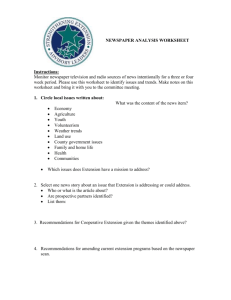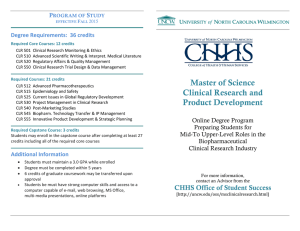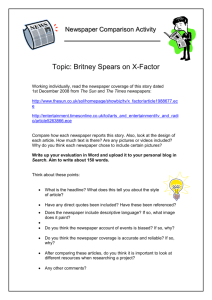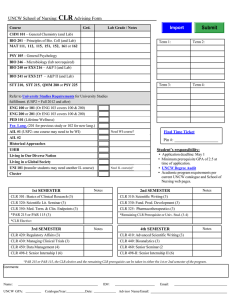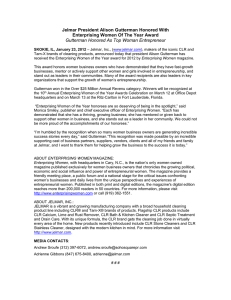SAC 4 2012 - willihighlegalstudiesyear11
advertisement
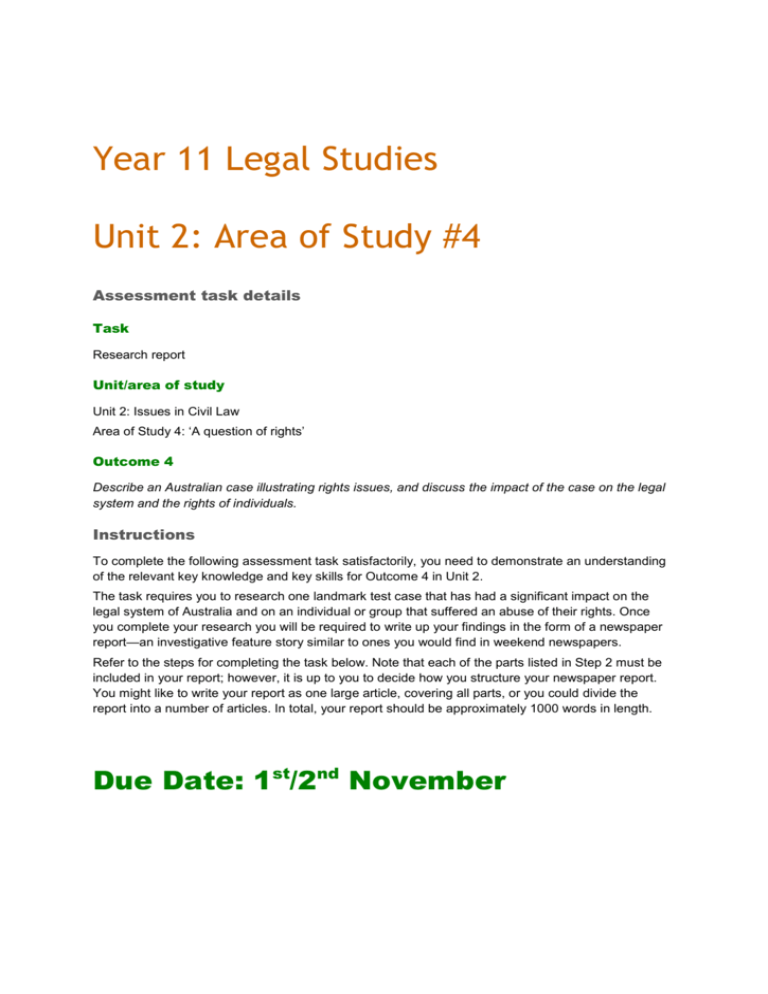
Year 11 Legal Studies Unit 2: Area of Study #4 Assessment task details Task Research report Unit/area of study Unit 2: Issues in Civil Law Area of Study 4: ‘A question of rights’ Outcome 4 Describe an Australian case illustrating rights issues, and discuss the impact of the case on the legal system and the rights of individuals. Instructions To complete the following assessment task satisfactorily, you need to demonstrate an understanding of the relevant key knowledge and key skills for Outcome 4 in Unit 2. The task requires you to research one landmark test case that has had a significant impact on the legal system of Australia and on an individual or group that suffered an abuse of their rights. Once you complete your research you will be required to write up your findings in the form of a newspaper report—an investigative feature story similar to ones you would find in weekend newspapers. Refer to the steps for completing the task below. Note that each of the parts listed in Step 2 must be included in your report; however, it is up to you to decide how you structure your newspaper report. You might like to write your report as one large article, covering all parts, or you could divide the report into a number of articles. In total, your report should be approximately 1000 words in length. Due Date: 1st/2nd November Step 1: Choose your focus case Your teacher will either allocate a case to you or allow you to choose a case. Either way, your newspaper article report should be based on one of the following landmark test cases: Mabo v. Queensland (No. 2) (Mabo) (1992) Wik Peoples v. State of Queensland (1996) 187 CLR 1 Dietrich v. The Queen (1992) 177 CLR 292 Roach v. Electoral Commissioner (2007) 233 CLR 162 Lange v. Australian Broadcasting Corporation (1997) 189 CLR 520 Tuckiar v. R (1934) 52 CLR 335 Croome v. State of Tasmania (1997) 191 CLR 119 R v. L (1992) 174 CLR 379 Step 2: Research Once you have chosen a case, begin conducting your research. Your research should cover the following details: 1 The individual or group that had their rights infringed—who were they? 2 Which right(s) was infringed? How was the right(s) infringed? 3 What role did the individual or group play in taking the case to court? What/who encouraged them? 4 What were the facts of the case? 5 What issues were in question? What point of view did the group/individual have on these issues? 6 What laws existed at the time of this case? How did they impact on the individual/group? That is, what specific laws affected the group/individual and compelled them to start legal action? 7 Which groups/individuals had opposing views on the issues in this case? What were these views? 8 What was the outcome of the case? Who was successful? What did the judges decide? 9 How did the decision affect the individual/group concerned? 10 How did the decision affect others, for example government, businesses and other like groups/individuals. Useful resources Your textbook Other textbooks www.austlii.edu.au www.theage.com.au www.heraldsun.com.au www.theaustralian.com.au www.highcourt.gov.au Where possible, use websites ending in gov.au or edu.au, although general searches using the name of the case should result in many relevant resources. Step 3: Organise your information Once you have completed your research, consider the structure and format of your report. Will you write one large, all-encompassing article, or will you divide your report into two or three smaller articles? This decision will then determine the way you need to organise your information. One way of preparing your report is as follows: Article 1: Describe the people involved, the rights that have been infringed and the role they took in bringing the case to court. Article 2: Describe the facts of the case, the issues involved and the conflicting attitudes in relation to the issues raised in the case. Article 3: Describe the outcome of the case and discuss how the individual/group was affected by the decision as well as how the legal system and other groups were impacted by the decision. Step 4: Write the report The final step is to write the report. It might be useful to see how other reports about court cases are written. Examine the structure and format of two or three newspaper articles on the case. You may have already read a number of newspaper articles as part of your research. If so, look at how they are written rather than just the content. If your research did not uncover newspaper articles on the case, use the websites listed above to help you locate some or conduct a search based on the name of the case. In-depth feature articles tend to include photos, illustrations, diagrams or maps. Include at least two graphical elements in your article. An engaging headline is also essential. This is a report on an aspect of the law, so remember to use legal terminology correctly. Before submitting your report, proofread it and then correct any errors. Assessment criteria Demonstrated understanding of the issues and law surrounding the case. Description of the role of the individual/group in bringing about changes in the law. Discussion of the impact of the outcome of the case on the individual/group, society and the legal system. Correct use of legal terminology. Thoroughness of research. Acknowledged sources of print and electronic information. Assessment rubric Name: ___________________________________________ Assessment criteria Very High (5) Demonstrated understanding of the issues and law surrounding the case Description of the role of the individual/group in bringing about changes in the law Discussion of the impact of the outcome of the case on the individual/group, society and the legal system Correct use of legal terminology Thoroughness of research Acknowledged sources of print and electronic information Total marks: ________ / 30 High (4) Medium (3) Low (2) Very Low (1) Not Shown (0)


